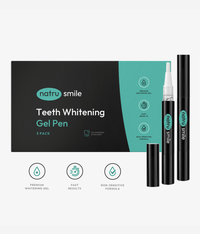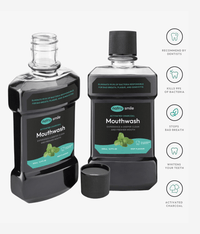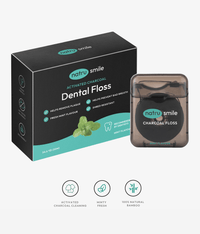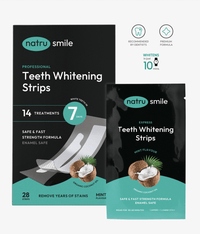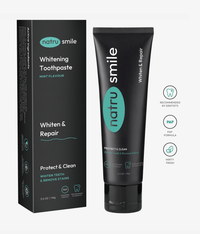
All products are certified by dental expert Dr. Greg Grillo
A broken tooth can be a real pain—literally! If you are dealing with a broken tooth, take the necessary steps to repair it as soon as possible.
If you have a broken tooth, you may experience pain, discomfort, and even an overwhelming sense of insecurity if the tooth is visible when you smile or talk. The truth is, one in three middle-aged Americans feels self-conscious about their teeth.
Fortunately, with proper treatment, you can get back to enjoying your smile in no time. Whether you need an emergency dental appointment or simply want to explore your options, there are plenty of ways to fix a broken tooth.
The aim of this guide is to provide you with all the necessary information you need to know when it comes to broken tooth repair. This includes the causes of a broken tooth, what should be done immediately when a broken tooth occurs, and answers to the most frequently asked questions about having broken teeth.
Why People Get Broken Teeth: Common Causes
As you bite down on some ice on a hot day, you detect something solid in your mouth that doesn't dissolve. As you look closer, you realize that it is a shard from your broken tooth. This is among the most common scenarios resulting in damaged teeth, but there are many others to look into.
Below is a list of the leading causes of broken teeth.
Tough Food
The most common cause of broken teeth is eating tough foods. From hard candy to crunchy chips, tough food can be very damaging to your teeth if you don't take the proper precautions.
The enamel, which is the thin outer layer of a tooth, is extremely strong, but it can still be damaged by eating overly tough foods. This damage can range from small chips and cracks in the enamel all the way up to large chunks coming off a tooth.
While tough foods are a common cause of broken teeth, you can avoid them by being careful when eating. Be sure to suck on hard candy, break down crunchy snacks, and never bite down on anything that is too heavy for your teeth.
Facial Trauma Following An Accident
Facial trauma can result from a variety of different accidents, including falls, motor vehicle collisions, and physical assaults.
Depending on the force and direction of an impact during an accident, teeth may become cracked or chipped, partially dislodged from their sockets (avulsion), or completely knocked out (extraction). In addition to this direct damage to the teeth themselves, surrounding structures such as soft tissues and the jawbone can also be affected.
Immediate medical attention is essential following any facial trauma to reduce the risk of long-term complications and preserve as much of a person’s oral health as possible.
Damage From Sports
Sports are an effective way to stay active, have fun, and build lasting friendships. They can, however, be particularly dangerous without the appropriate protective equipment.
Unfortunately, broken teeth are a common occurrence when playing sports, especially if you’re not wearing a mouth guard. A whopping 10-20% of all sports-related injuries are maxillofacial injuries.
The types of sports that cause the greatest risk for dental trauma are those that involve contact with other players or objects like balls, sticks, or pucks. Even in non-contact activities, such as biking and skateboarding, a fall or collision can result in broken teeth.
The severity of a dental injury sustained during sports depends on the force and speed at which it occurs. Minor injuries may only involve chips or small pieces of enamel coming off the tooth, while more serious ones might cause larger fractures that extend deep into the root canal system of the tooth.
Broken teeth can have serious long-term consequences if they are not treated right away with proper dental care. With immediate broken tooth treatment, your teeth will look and function normally again.
Untreated Cavities
Many people may also suffer from broken teeth due to untreated cavities. By eating sugary foods and drinks, bacteria produce acid that weakens your teeth's enamel, causing cavities.
When left untreated, these cavities can cause serious damage to your teeth, resulting in pain and other discomforts, as well as leaving you with a less-than-perfect smile. Meanwhile, an infection can occur along the gum line and inside the root canal, as well as in nerves and connective tissue.
When it comes to tooth decay due to cavities, prevention is always better than cure. The most effective way to prevent cavities from developing is through regular brushing and flossing combined with decreasing sugar intake and visiting your dentist regularly for checkups.
Large Amalgam Fillings
Amalgam, or "silver fillings," are essentially a mixture of metals that serve as tooth fillings, about half of which is elemental mercury. An amalgam is then formed when elemental mercury reacts with and binds together silver, copper, tin, and alloy particles. It is strong and long-lasting but can be prone to cracking or breaking over time.
The primary reason why large amalgam fillings may cause broken teeth is that they can become too bulky for the tooth structure itself. When this happens, it places additional pressure on the tooth, which can lead to fractures in both the enamel and dentin layers of the tooth surface.
Another common cause of broken teeth associated with large amalgam fillings is corrosion. When exposed to moisture or acids from food and drinks, the metals in an amalgam filling can corrode and weaken over time. This weakening can make a tooth more susceptible to fracture or breakage when it is subjected to pressure from normal chewing or biting activities.
Finally, exposure to extreme temperatures, such as very hot foods or beverages, can also lead to broken teeth due to the expansion and contraction of metal materials in response to temperature changes in the amalgam.
Other Factors
Broken teeth can have a range of causes. Aside from the more obvious causes, such as trauma or accidents, there are other lesser-known reasons why people may end up with broken teeth.
One of the most common causes is bruxism, which is the excessive grinding of the teeth during sleep. The enamel of the teeth can gradually wear and tear, causing cracks and chipped teeth.
Age could also be a contributing factor to teeth becoming misaligned, weaker, and more prone to breakage. As we age, the bones in our jaw become less dense, which allows the teeth to shift and move out of place over time.
In the case of a broken tooth and you are not aware of its cause, it is recommended that you consult a dentist in order to determine the cause and initiate proper broken tooth repair procedures as soon as possible.
What To Do With A Broken Tooth
Did you just break a tooth? First of all, try to stay calm. It is understandable that this can be an alarming and uncomfortable experience.
That said, you need to know what steps to take in order to prevent further damage to your teeth as well as to obtain the best possible outcome for your dental health. Read on for some helpful guidance on what to do next.
Rinse Your Mouth With Warm Water
Rinsing your mouth with warm water after breaking a tooth is a necessary first step for both comfort and health. Warm water helps to reduce any pain or discomfort from the broken tooth while also allowing you to flush away bacteria or debris that could cause infection.
This step can help prevent further damage to the tooth by reducing inflammation in the area, allowing it to heal more quickly.
Apply Pressure To Any Bleeding Areas
When you have a broken tooth, it can be quite painful and even cause bleeding. Applying pressure to the area of the broken tooth is a crucial step in managing this injury. This helps to prevent any potential bleeding that may occur from the break, as well as reduce inflammation and discomfort.
The ideal way to apply pressure is by using a clean cloth or gauze pad directly over the wound. Apply firm but gentle pressure for several minutes until the bleeding has slowed or stopped entirely. For minor breaks and fractures, the pressure should be sufficient to stop the bleeding and reduce any pain.
If you notice that your mouth continues to bleed after applying pressure, seek medical attention immediately for further treatment, as a more serious intervention may be necessary.
Apply An Icepack To Your Cheek
Applying an icepack, or even just a bag of frozen peas, to the side of your face that has the broken tooth can help to reduce discomfort.
The cold temperature of the pack constricts blood vessels, reducing blood flow to the area and numbing it temporarily. This numbing effect allows you to rest more comfortably while waiting for medical attention or until you are able to visit a dentist for further treatment.
As tempting as it may be, it's best not to place an ice cube in your mouth as this may cause further discomfort because of sensitivity to exposed nerves.
If It’s Painful, Use An Over-The-Counter Pain Reliever
Over-the-counter pain relievers like benzocaine can provide relief because they act as local anesthetics (numbing drugs). Medicines such as ibuprofen that reduce inflammation also work well.
Not only can they help to alleviate some of the immediate discomfort and inflammation, but they can also reduce the risk of any infection that may occur in the damaged area.
In addition, taking a pain reliever will give you time to make an appointment with your dentist for further treatment. Be sure to follow all instructions provided by your doctor and always read labels carefully before taking any medication.
Cover Any Broken Teeth With Milk, Saliva, Or A Saline Solution
If you have a broken piece of tooth, make sure you save it! There is a possibility that your dentist can still reattach it. When handling an adult tooth that has been knocked out, hold the crown and not the root (the yellowish pointy end).
Cover the tooth with milk, saliva, or a saline solution - don't use water. Don't scrub off dirt or debris, either. Solutions such as milk contain sugars and proteins that cells need to stay alive and antibacterial components that are necessary for the survival of the tooth. Most importantly, this will keep your lost tooth moist at all times.
How To Protect Your Mouth Until You See A Dentist
Having a broken tooth can be stressful. To start with, schedule an appointment with your dentist as soon as possible. As long as the fragment is preserved in saline solution or milk, it can be reattached if done immediately.
Before visiting your dentist, protect your mouth from further damage by avoiding hard or sticky foods that could put pressure on it and cause additional fractures. If possible, try to avoid eating with that side of your mouth until you get to the dentist for treatment.
Make sure you keep your mouth clean by gently brushing around the affected tooth twice a day. You should also floss around the area to prevent food particles from becoming lodged in your teeth.
Protection With A Temporary Tooth Repair Kit
To protect your teeth after a broken tooth, apply a temporary tooth repair kit. Like teeth whitening kits, these kits provide immediate dental care at home while you await a dental appointment.
Temporary tooth repair kits are designed to provide quick and easy solutions to minor dental problems such as chipped or cracked teeth, missing fillings, or even lost crowns. The main component is a special type of adhesive that attaches directly to the damaged tooth surface.
Most kits also come with a temporary filling material that can be used to fill any gaps or cavities on the affected tooth, helping you maintain a full smile while waiting for dental treatment. Depending on the type of kit you get, it could cost anywhere from $10-50, making it an excellent temporary solution.
Be sure to inform your dentist about any changes or issues with your teeth after using a temporary repair kit so they can provide you with proper care.
How To Fix Broken Teeth: Top Solutions
Having a broken tooth can be incredibly painful and frustrating. Not only that, it can cause serious dental health problems if not treated properly. Luckily, there are many solutions available to help fix your broken teeth and get you back to smiling confidently again.
Let's discuss the most effective broken tooth treatment procedures.
Veneers
Veneers are thin shells of porcelain that are custom-made for an individual’s mouth and bonded directly onto their existing tooth structure. This type of procedure is relatively simple and does not require extensive preparation or removal of healthy tooth structure like other dental treatments might.
The primary benefit of veneers is the aesthetic enhancement they provide by covering any chips, discoloration, cracks, gaps between teeth, or misalignment in the smile. By covering broken teeth with a strong and natural-looking veneer, one can dramatically improve their overall appearance.
With proper care and regular checkups, they can also last for many years and provide beautiful, natural-looking results that will help you feel confident about your look.
Bonding
Dental bonding is another highly effective broken tooth replacement procedure. It is a process in which an enamel-like material, usually made of composite resin, is applied directly to the tooth surface.
This substance can be tinted and shaped to match the color and shape of natural teeth, making it virtually undetectable. Once applied, dental bonding quickly hardens and bonds with the tooth structure for long-lasting results.
For covering stains that can't be removed by professional teeth whitening, veneers are an ideal choice, whereas dental bonding works better for repairing chips or gaps.
Composite bonding is more cost-effective than veneers, as it generally costs between $300 and $600 per tooth, depending on the difficulty of the procedure. In contrast, porcelain veneers can be quite expensive, costing up to $1,500 or more.
Root Canal
Root canal treatment is one of the most popular ways to fix a broken tooth because it can help preserve the tooth’s natural structure and prevent further damage.
The procedure involves removing the infected pulp tissue inside the root canal, cleaning out any bacteria or debris, and then filling in the area with a special material called gutta-percha. This material, derived from a Malaysian tree called the percha tree and shaped like a cone, is able to fit into all of the crevices in your teeth because it has been heat-treated or chemically altered beforehand.
A root canal prevents future infections from occurring and helps maintain healthy oral hygiene habits for years to come. The amount of time required for treatment varies depending on factors such as the severity of decay and the size of the affected area but it usually heals within a week and can last for as long as ten years under proper dental care.
Filling
Using a variety of materials, such as gold, porcelain, silver amalgam, plastic composite resin fillings, or glass ionomer, dental fillings can repair cavities, chips, cracks, and other minor damage caused by decay or trauma.
Essentially, the filling material is placed in the damaged area of the tooth, sealing it from further harm. The best filling material for you will depend on the location and size of the damaged tooth, the cost of the material, and the recommendation from your dentist.
Dental Sealants
Dental sealants are thin plastic coatings applied directly to the surface of a tooth, usually the chewing surfaces of molars and premolars. By forming an airtight bond with the enamel, sealants can act as a shield against decay-causing bacteria, acids, and other debris, preventing them from entering crevices or grooves in your teeth.
While fillings are done to repair a tooth that has been damaged as a result of dental decay, such as a cavity or hole, a sealant serves a different purpose: it acts as a protective covering for a part of the tooth in order to prevent damage from occurring.
The application process for dental sealants is quick and painless. In most cases, it can be completed in just one visit to the dentist's office.
Dental Implants
Unlike other broken tooth replacement treatments, such as dentures or bridges, dental implants are placed directly into the jawbone and become part of your body’s natural structure. This ensures that they don’t move around when you eat or talk, providing you with a secure fit in your mouth.
Unlike other broken tooth replacement treatments, such as dentures or bridges, dental implants are placed directly into the jawbone and become part of your body’s natural structure. They won’t move around when you eat or talk.
The dental implant itself is made out of titanium, a highly durable and non-toxic metal that won’t cause any harm if it comes into contact with other parts of your body. Once the implant is placed, a crown or bridge can be attached to it, giving you a complete and natural-looking smile.
These implants are designed to be long-lasting and require very easy maintenance once they’ve been placed. This means you don’t have to worry about them breaking down over time due to wear and tear. When cared for properly, the implant itself can last for your entire life, while the crown attached to the implant typically requires replacement only every 15 to 20 years.
Surgery
Dental surgery is a process that entails various steps depending on how severe the damage to the tooth is.
Initially, your dentist will assess the injury and, if necessary, take x-rays or scans for a more detailed analysis. After careful consideration of what needs to be done, they can then move forward with dental operations.
This might involve cutting away any broken parts of your tooth structure and reconstructing it using replacement materials, such as crowns or bridges, to replace missing pieces of enamel. Recovered tooth fragments may also be reattached with adhesive.
Extraction
In some cases, particularly when a tooth has been broken beyond repair, dentists may perform an extraction. Decay can be treated with fillings or a root canal treatment if it hasn't progressed too far.
If the damage is extensive, however, the tooth may not be able to hold up despite being crowned. Teeth can also fracture due to biting hard objects or facial trauma, such as sports injuries and falls. Sometimes children also need teeth removed in order for orthodontics to work properly.
In these cases, your dentist may recommend extraction, which entails removing the entire damaged tooth to make way for a new, healthy replacement. Extracting a tooth can help prevent further damage and infection from spreading throughout the mouth, as well as provide an opportunity to replace it with either an implant or bridge.
Fix a broken tooth successfully by taking note of these key points.
How Much Does It Cost To Repair A Broken Tooth?
There is a range of techniques to fix or replace broken teeth, and the associated costs differ as well. Bonding a tooth could cost anywhere from $100 up to $1,000, depending on how much work needs to be done. Fillings may be priced between $90 and $500. Dental veneers, which may cost up to $1,500, are among the most expensive cosmetic procedures.
Can A Half-Broken Molar Be Fixed?
A molar that is only partially broken can generally be repaired in one of two ways. If the break is not extensive and all pieces are still connected, it may be possible to bond them back together. If the fracture is more serious, your dentist might need to use a dental crown or filling material to cover up the split.
Is Dental Glue An Option For A Broken Tooth?
Dental glue, also known as dental cement, is a type of adhesive specifically formulated to help mend broken teeth and prevent further damage. Generally, it is marketed as a temporary solution for chipped teeth, cracked veneers, and fractured crowns.
Tooth Broken Below The Gum Line: What Are Your Options?
If one of your molars is fractured beneath the gum line, you should visit your dentist right away. Generally speaking, these teeth cannot be rescued but must be removed and substituted with a dental prosthesis.
However, in some instances, crown lengthening or gum restructuring can be done to retain the tooth, depending on its size. Your dentist may potentially salvage it if attended to promptly. The quicker you take action, the greater your chance of success and the lower your risk of infection due to exposed nerves and vessels.
How To Pull A Broken Tooth?
Your dentist will use specialized tools to delicately loosen your tooth and take it out of its socket. It's possible that your dentist may need to cut into your gums if your tooth is severely damaged or broken off at the gum line in order to access it.
In some cases, at-home alternatives, such as manually wriggling and twisting with a clean hand, may be possible, but this is not recommended by dentists.
What To Do If A Part Of A Tooth Breaks Off?
If your tooth has been damaged in any way, schedule an appointment with a dentist right away. To preserve the broken fragment and keep it from drying out, store it in saliva or milk.
These solutions ensure the cells in the tooth have access to essential sugars and proteins while also containing antibacterial properties that help the tooth stay alive.
Is It OK To Leave A Broken Tooth?
If you’ve broken a tooth, schedule an appointment with your dentist as soon as possible. Leaving a broken tooth untreated can pose serious health risks.
Even if the fracture doesn't cause any pain or bother you, it could still lead to other issues like food particles getting stuck in the damaged area and resulting in an infection.
What Can Happen If A Broken Tooth Goes Untreated?
Failing to address a broken tooth can result in dental issues such as cavities, tenderness, and even loss of the tooth. Eventually, the split can cause more severe oral problems, such as bacterial buildup in the crevice that could lead to an abscess or infection.
If left untreated, this infection that has been caused by your damaged tooth might spread throughout your body and become a major health risk.
How Long Can You Stay With A Broken Tooth?
Depending on the severity, it can take a while (from a few days to several weeks) for a broken tooth to fully fall out. However, you should not wait for this to happen as there are potentially serious problems that could arise from leaving it. Food particles may get stuck and cause infections if the broken tooth isn’t taken care of right away.
Why Does My Broken Tooth Not Hurt?
If you fracture or crack a tooth, it is possible that only the enamel has been affected and not the dentin. In these cases, you may not experience much discomfort beyond a slight ache.
Dentin is situated underneath the enamel and makes up a major part of the tooth. When it is exposed due to a broken tooth, numerous complications may arise, as it is the last layer before reaching the dental pulp cavity, which contains nerves and blood vessels.
Why Are My Teeth Breaking All Of A Sudden?
Some foods and drinks we consume may make our teeth more prone to breakage. The enamel on our teeth can wear away gradually due to daily exposure to acidic or hard substances.
Over time, the protective layer of enamel becomes weaker as we age, making the teeth more susceptible to damage.
Can You Brush A Broken Tooth?
It is still possible to clean a fractured tooth. However, it needs to be done with caution. Brushing the broken tooth too firmly can result in additional distress or destruction of the tooth, particularly if the nerve inside is uncovered.
Additionally, you should avoid biting down on the damaged tooth and drinking liquids that are either too hot or too cold, as this could increase discomfort.
Do All Broken Teeth Need To Be Pulled?
Not all broken teeth need to be taken out. Sometimes, simple dental bonding can fix a chipped tooth. If kept in a saline solution, the tooth fragment can also be reattached within a certain time window. In the event of severe damage and a break at the gum line or cracks, an extraction may be necessary.
Why Do Teeth Break In Half?
One of the most frequent sources of broken teeth occurs from decay. This means teeth with cavities that have not been treated are at higher risk for breaking and leading to an urgent dental situation. Additionally, sudden impacts like falling, being hit in the face unexpectedly, participating in sports activities, or being involved in an accident may also cause a tooth to break in half.
Can Half A Tooth Be Saved?
It might be possible for your dentist to save the rest of your tooth if only a small part has been broken off. A crown or filling could be used to secure it. However, if the fracture is more serious, then an endodontic procedure (root canal) may need to take place in order to remove the damaged area and protect both the pulp and tooth.
Can A Dentist Fix A Badly Broken Tooth?
Fortunately, most damaged teeth can be fixed with relative ease. A badly broken tooth, on the other hand, may require more extensive dental procedures, such as a root canal or an implant. The treatment plan for each individual, however, is different, and each broken tooth requires its own specific treatment plan.
Can A Dentist Fix A Broken Tooth In One Day?
A dentist may be able to fix a tooth with only minor enamel loss in one session. The procedure may take from 90 minutes to three hours. A more significantly broken tooth will require a more involved procedure that may need multiple visits to the office.
What Should You Avoid With A Broken Tooth?
When you have a broken tooth, you should be mindful of what you eat and drink to protect the exposed area from further damage. Avoid eating anything hard or crunchy, as this can cause more serious damage to the broken tooth. Additionally, extremely hot or cold food and drinks can cause extreme sensitivity and pain.
It is advisable to also stay away from sugary drinks, which can feed any existing bacteria and cause further damage to your teeth.
Can A Broken Tooth Be Left In The Gum?
It’s important to remove a broken tooth as soon as possible. Not extracting it can make it vulnerable to dental problems, which may result in discomfort and inflammation.
Bacteria can also penetrate a fractured tooth and spread, potentially leading to the formation of an abscess. If left untreated, this infection could spread throughout the body, posing a serious health risk.
When Is It Too Late To Save A Tooth?
When it comes to saving a tooth, the earlier you act, the better. If the root of the tooth becomes severely infected and a significant amount of it has been damaged, there is no way to save it, even with a root canal procedure.
When decay is too widespread, or the gums are too infected to support and structure the teeth, extraction is usually necessary.
At What Age Do Teeth Start Breaking?
Among adults with permanent teeth, the majority of cases of partial or full tooth loss occur in middle-aged adults aged 50 and above.
As we get older, our teeth can become weaker and more susceptible to cracks due to a variety of factors like poor lifestyle choices, illnesses, accidents, or even activities such as chewing food, grinding teeth at night, or biting incorrectly.
What Is The Cheapest Way To Fix A Broken Tooth?
Dental bonding is usually the most cost-effective broken tooth treatment that is done professionally. This also serves as the fastest and simplest technique to address a chipped tooth. Before your next dental appointment, you can also use at-home filling kits as a temporary solution.
Dental crowns are used when the whole top of the tooth needs replacing due to a large chip or fracture, then dental crowns are used. If your entire tooth needs to be replaced, you will need dental implants.
Can A Broken Tooth Get Infected?
If the break in the tooth is significant, it can open up access to the pulp. The pulp of a tooth contains nerves and blood vessels, and if bacteria gain entry, it may lead to an infection. If this happens, the tissue within the pulp could be damaged or even die off due to the chip. Significant oral damage could result from this.
Can A Broken Tooth Be Replaced Permanently?
Dental implants are an effective and permanent way to restore your smile if you need to replace a single tooth or multiple teeth in various locations. These replicas of real teeth both look and feel genuine, and with proper care, an implant can last a person a lifetime. The crown connected to the implant may need to be replaced every 15-20 years.
Wrapping Up
The experience of having a broken tooth can be stressful and frustrating. With the right knowledge and techniques, you can repair your broken tooth safely and effectively without experiencing any pain or discomfort.
Your best course of action is to visit the dentist right away to have your tooth repaired as soon as possible. Keep the fragmented tooth with you in case it can be reattached.
Even if your tooth is lost, various dental procedures can be done to have your teeth returned to their original state so that you can regain your confident smile.


